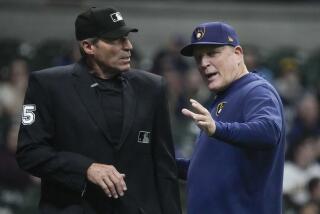BEHIND IN THE COUNT
- Share via
Rich Gonzalez has everything he needs to fulfill his dream of becoming a major league umpire.
He has the skills, the character, the intelligence, the passion.
“It’s what I want to do with my life,” he says.
What he may never get, however, is the opportunity.
That’s because the big league umpire roster has only slightly more turnover than the U.S. Supreme Court. In fact, between 2004 and last season the Supreme Court actually got more new justices (two) than baseball did new umpires (one).
And that has made it difficult for baseball to make progress in its effort to broaden an umpire corps that is more than 91% white.
“We’re keenly aware of the need for diversity,” says Rich Rieker, a former umpire and now an umpire supervisor for Major League Baseball. “And we’re keenly aware of what we need to do.”
But getting it done will be a challenge. The road to the majors for an umpire is longer and more arduous than the ones facing officials in other major professional sports, rutted by low pay, a grueling work schedule and backbreaking travel.
And there’s no guarantee that road will end in the big leagues because the overwhelming majority of minor league umpires quit or are released long before their 10- to 12-year apprenticeships are over.
“It’s not attractive at all,” Cris Jones says.
Jones should know. He became an umpire right out of college, graduating from umpire school at the top of his class and becoming, according to longtime major league umpire and instructor Harry Wendelstedt, one of the most promising young umpires he has ever seen.
Eleven years later, his path to the majors blocked by the low turnover, Jones couldn’t even qualify for a car loan. So he eventually joined Rieker as an umpire supervisor and now finds himself trying to recruit people to follow the same path that eventually wore him down.
“It’s such a challenge,” he says. “To try to tell these kids, ‘Hey, you may not make it. But give me five to 10 years of your prime to find out.’ That’s tough to do that.”
Especially given the working conditions. Although minor league baseball has never been more profitable, shattering attendance records in each of the last four seasons, salaries for umpires in 14 of baseball’s 16 U.S.-based minor leagues last season ranged from $450 to $600 a week, according to the Professional Baseball Umpire Corp., which oversees minor league umpiring.
In the majors, umpires can make as much as $300,000 a season but only seven men have made that jump since 2000. And going into last season, 37 of the big leagues’ 68 full-time umpires had worked at least 10 seasons in the majors.
“I don’t fault minor league baseball for the pay structure,” Jones says. “Minor league baseball shouldn’t be a place you retire from. It’s a place to keep a dream alive to go to the major leagues.
“But it’s tough. Because you have to start from scratch at such a prime age.”
As he talks, Jones is sitting in the third base dugout of an auxiliary field at baseball’s Urban Youth Academy in Compton. Behind him nine big league umpires are drilling 44 amateur arbiters on everything from foul balls to footwork.
For 51 weeks each year the academy develops players. But last week the fields were turned over to Little League, high school and college umpires.
Among those who came out was Kevin Danley, the older brother of major league umpire Kerwin Danley and an overseer of officials for the L.A. City Section. He applauds the efforts of Rieker and Jones because the lack of qualified minority umpires isn’t only an issue for professional baseball. It’s a crisis for urban high schools and junior colleges too.
“Just to get young minorities to come out, that’s a big problem,” Danley says. “It’s very important to see other minorities out doing the job. They figure they can do it too.”
But recruitment, he says, “is getting worse, it’s not getting better.”
Wendelstedt agrees. He has been teaching umpires for more than four decades and says the number of talented minority students is as low as it has been in years. But Rieker’s decision to come to Compton and focus on grass-roots development, he says, will help.
“We have an obligation wherever we’re teaching players to play and coaches to coach to teach people how to umpire those games,” says Rieker, whose two-year-old camp concluded its second session Sunday. “What we want to try to do on a broad basis is just try to make umpiring better for all levels.
“It’s a good strategy for us to develop talent and it’s also a great way to find talent. We should have been doing this a long time ago.”
Developing minority umpiring talent is an area in which baseball is clearly struggling. Although more than 40% of the players in the major leagues are Hispanic, African American or Asian, there are only three blacks and three Latinos among the 70 full-time major league umpires.
That lags far behind the percentages in other professional sports. Twenty-five of the NFL’s 120 game officials -- 21% -- are minorities, for example, including eight of the 15 officials hired in the last four years.
Basketball has done even better. Although the NBA does not compile those statistics on its officials, a study by the Institute for Diversity and Ethics in Sport at the University of Central Florida found that in the 2006-07 season, 36% of the league’s 59 officials were either black or Latino.
The NBA is also the only major pro sport with a female official, Compton’s Violet Palmer.
“It’s important because we want diversity in every area of our game,” says Jimmie Lee Solomon, MLB’s executive vice president for baseball operations. “There’s been a lot of focus to the players on the field but less focus is brought to the umpires. We don’t have very many minority umpires. So we’ve been working to increase those numbers.
“The way you do that is to increase the pipeline.”
To help do that, baseball will give as many as eight umpires in last week’s camp scholarships to one of two umpire schools in Florida in January, the necessary first step toward becoming a professional umpire.
Seven umpires who attended last November’s Compton camp already are working in the minor leagues.
The fact that all seven are white doesn’t really matter because, Solomon and others say, the goal was never to create an affirmative action program. The goal was to generate interest and create opportunity and that, in turn, will eventually draw qualified candidates of all backgrounds.
“They’re trying to find the best umpires. They’re just reaching out to find them,” says major league veteran Brian Gorman, an instructor at last week’s camp.
“Major League Baseball is not going in there saying, ‘We’re only sending minorities,’ ” adds Alfonso Marquez, a camp instructor last fall and the major leagues’ only Mexican-born umpire.
“The camp is not necessarily just minority. It’s really for people that don’t have the resources to be able to go to umpire school.
“Opportunity. That’s the biggest thing.”
And that’s all that Rich Gonzalez is asking for. A high school and college umpire in St. Louis, Gonzalez, 19, came to Compton well aware of the challenges.
“They said a year in rookie ball, a year in A ball, a year in double A, five to six years in triple A. And then maybe you might get called up,” says Gonzalez, whose father, also a college umpire, was Rieker’s roommate at umpire school 24 years ago.
But while Rieker went on to the big leagues, Gonzalez’s father went home to St. Louis to get married and start a family. So what was once his dream is now his son’s.
“This,” Gonzalez says, “is what I want to do.”
--
More to Read
Go beyond the scoreboard
Get the latest on L.A.'s teams in the daily Sports Report newsletter.
You may occasionally receive promotional content from the Los Angeles Times.










